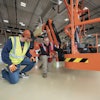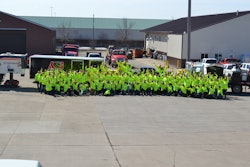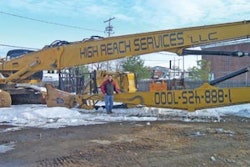Early one Saturday morning, two friends were having a cup of coffee together doing what businessmen do - discussing business. Despite both being concrete contractors, their backgrounds, businesses and successes could hardly be different.
John Gains runs a $20 million business that serves the commercial, industrial and institutional markets. He founded his company 20 years ago with his brother Ted. They started out pouring patios, sidewalks, and driveways for home builders and home owners. John bought out his brother 10 years ago, switched the company's focus and grew his company into the machine it is today.
Terry Fulton had a far different introduction to the concrete business. His father owned and operated a small concrete company. Terry went to work for his father in the field at age 16 but moved onto other companies after dropping out of high school. He continued to work in the field forming, pouring and finishing concrete during his teens and twenties. For years, Terry rejected his father's invitations to join the family business.
10 years ago, after being frustrated by the poor leadership and unsteady hours of the companies he worked for, Terry changed his mind and joined his father. His confidence as a businessman grew so much over five years that he ended up buying his father out. The company pours residential foundations, driveways and patios. Terry's company has topped out at $2 million in sales.
During this morning's conversation with John, Terry revealed that despite hitting his financial goals most years, he really doesn't have any idea what individual jobs cost him. John sympathized with Terry's plight.
He remembered how much harder it was to track costs back when his company was doing jobs that ran between one and two days. Today, his typical project runs several weeks. His team tracks all costs per job, he knows each job's profitability and his estimators excel at cost prediction. John had discovered a truth about job costing - the smaller the average job, the harder it is to track costs in a meaningful way.
John took a slow drink of coffee and decided to try and help Terry out. "What is keeping you from knowing your project costs?"
Terry explained. "When we run a job cost report from our accounting system it shows the labor charges assigned to the job and the materials that were delivered to the job. The report doesn't include material taken from inventory such as nails, wood, plastic sheets and gravel. The report doesn't include the cost of our equipment, such as our Bobcat, nor labor burden, nor overhead."
Terry's answer told John everything he needed to know about Terry's approach to job costing. It was filled with holes. John proceeded with his questioning.
"How do you estimate jobs," John asked?
"I predict the labor time and material costs then add in overhead. I double check the cost per square foot or cubic yard against our averages to make sure I didn't blow a calculation. Dad had so much experience he could look at a job and just know. I can't do that," said Terry.
"Okay. More questions. How are you tracking time," asked John?
"My foremen write down the hours each worker worked and what job they worked on. Many of our jobs span two days, so the foremen note the time the crew finishes the first job and moves on to the next," Terry responded.
From his own experience with small residential jobs, John knew most of Terry's jobs varied greatly in preparation, forming and finishing. Terry wasn't tracking the labor in a useful way. John continued on.
"Does the time required for base preparation, layout and forming per square foot run consistent or does it vary greatly," asked John?
"The average varies greatly between driveways, patios, and sidewalks and it even varies quite a bit within each category. Curved driveways and sidewalks throw all the averages off," said Terry.
"Have you tried to track the labor time by task," asked John?
"I don't understand your question," said Terry.
"Have you ever asked your foremen to note the time spent prepping the ground, the time spent installing the forms, the time spent pouring, and the time spent finishing," John asked.
"Yes, and it created a mess. My foremen complained. My bookkeeper complained. The timecards were loaded with errors and the data didn't make any sense. We gave up," said Terry.
Terry's response brought back many painful memories for John. He had fought this battle for years. He explained to the foremen why job costing was so important to the amount of work his company could provide them.
That worked with several of his foremen but not all. He finally laid down the law to his foremen and superintendents. When he made recording labor time by work task a non-negotiable part of their job, the entire team started doing a better job with the paperwork.
"Terry, first of all, you need to track the time spent on the major tasks. You will never be able to estimate and schedule accurately without that information. Second, you must be firm with your foreman and bookkeeper. They will record and store that information accurately. Oh, and change your time cards. Assign cost codes to each major task and put the codes on the back of the timecard," said John.
"How many different codes should I use? Do I try to catch all of their activities," asked Terry?
"Focus on the activities that account for 80% of their time. My rule of thumb is 'Never try to track more than four activities per crew per day,'
"When I was your size, my foremen tracked time by the major components: ground preparation, layout, forming, pouring and finishing, cleanup, and drive time. The projects my company now performs allows us to have specialized crews.
"Each crew has its own set of cost codes. For example, our forming crew tracks layout time, forming time, break-down and clean-up. They also track the part of the job they are working on, whether it is footings, slabs or walls," said John.
"Wow. My foremen and bookkeeper are going to throw a fit," Terry stated.
"That's why you have to make proper tracking a non-negotiable. By the way, you should also track your equipment by the job. Unless all jobs need the exact same equipment, you need to spread the cost of the equipment only over the jobs that use it," said John.
"Why can't I just roll my equipment costs into overhead," asked Terry?
"You will end up over-estimating the cost of jobs that don't need the equipment and under-estimating the cost of the jobs that do need it. You might lose good jobs and win bad ones," said John.
"Ouch. Okay, so how can I track the use of inventory," Terry inquired.
"Honestly, we still fight that one. If I were in your shoes, I would assume the quantity estimated is what went in," John said.
"How is my accounting system going to reflect that," asked Terry?
"Great question. Unless you are using sophisticated or customized accounting software, your accounting system will probably never produce a report that shows the true job costs. We have special reports written into our package.
"When I was your size, we relied on Excel spreadsheets. We loaded the labor hours, equipment hours, and inventoried material quantities into a spreadsheet and calculated the costs based on our fully burdened labor rates, our average material costs, and our hourly equipment rates. We added in all other direct costs such as delivered materials and subcontractors. We compared the cost produced by our spreadsheet against the cost we estimated for the project," John stated.
"That sounds like a lot of work. Is there a quick and dirty way," Terry asked?
John smiled at Terry's question. Everyone wants a fast and simple solution to tough problems. In this case, there was one.
"Just track your labor hours per cost code. Compare the hours used against the hours estimated. If you are good on hours, you should be close on cost and schedule," stated John.
"I always thought that might work. What's the downside," Terry asked.
"Construction isn't the most profitable business in the world. Running a little over on materials or using equipment inefficiently eats holes into your profits. Not as much as running over on hours, but it does hurt," said John.
"John, you've got THAT look on your face again. What are you holding back," Terry asked?
John didn't want to insult Terry, but Terry asked for it.
"Terry, you may be still missing a critical benefit of job costing. It allows you to set up effective bonus systems for motivating and rewarding fast work. Having fast crews is a tremendous competitive advantage and virtually recession proofs your business all by itself," said John.
Terry was just beginning to realize John's real message: job costing is essential to running a construction business profitably. That's why Terry enjoys his coffees with John. John's been there, done that and willing to help Terry as long as Terry listens.
For large concrete contractors such as John, job costing is fairly straight forward and easy to get right. For small concrete contractors such as Terry, job costing is a never ending headache - but it is essential to the long term health of every construction company.



















